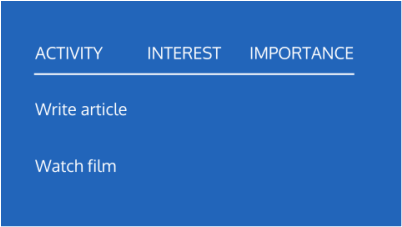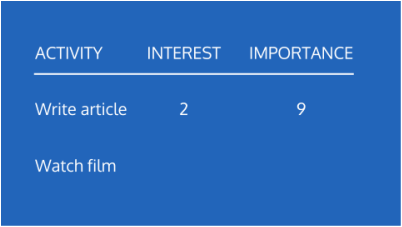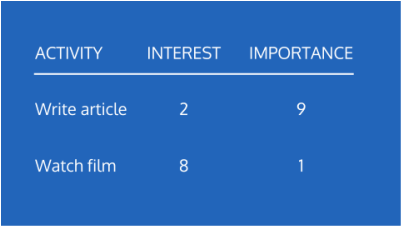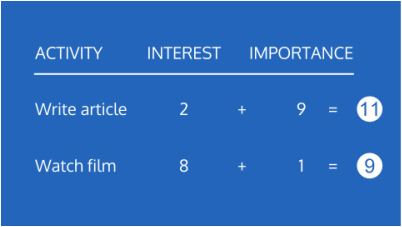Humans have a lot of defects. The Blame Reflex, and our innate "Us vs Them” pathology are two big ones.
Our defects lead us to behaviours that aren't in civilisation's best interest, or even our own best interest. No single human's behaviour has been, or ever will be perfect. Every one of us behaves badly sometimes, as you might have noticed.
Yet civilisation is improving. How is this possible?
Here's one explanation.
If you applied these 2 attributes – 'Good for the individual human', and 'Good for civilisation' – to all human behaviours in a big list, you'd wind up with four types of behaviour:
Our defects lead us to behaviours that aren't in civilisation's best interest, or even our own best interest. No single human's behaviour has been, or ever will be perfect. Every one of us behaves badly sometimes, as you might have noticed.
Yet civilisation is improving. How is this possible?
Here's one explanation.
If you applied these 2 attributes – 'Good for the individual human', and 'Good for civilisation' – to all human behaviours in a big list, you'd wind up with four types of behaviour:
- Bad for everybody (B)
- Good for the individual, bad for civilisation (GI)
- Good for civilisation, bad for the individual (GC)
- Good for everybody (G)
1. We agree on basic logic
Bad for everybody (B) and Good for everybody (G) are easy. We all agree behaviours that are good for everyone should be maximised, and behaviours that are bad for everyone should be eliminated. That’s a consensus, and a fundamental factor in civilisation’s improvement. But it’s not the only factor.
2. Human productivity increases over time
Despite our innate defects, humans also have innate gifts. One of them is the compulsion to create. We create things, and we share them, and that's all wealth is: productivity. Human wealth production increases over time. Now, we're not as good at sharing that wealth as we are at creating it (take a look at income inequality) but we create wealth at an increasing rate nevertheless. Creating this wealth of new resources is a (G) behaviour (even though it has side effects we need to address, like the effect our prolific productivity has on our climate).
Our productivity creates not just goods and services, but tools that offer us opportunities to do entirely new productive behaviours. Consider how readily available computer coding is now, compared to its non-existence in the 1916's. Our productivity actually creates new (G) behaviours, and it happens all the time.
The effect of this trend to create more (G) behaviours is that there is an increasing ratio of behaviours that are good for everybody, and a much slower increase in the number of behaviours that are bad for everybody (B) – because nobody is busy thinking up new ways to do things that harm us all. (Although sometimes we get new (B)s as side effects of our productivity, like in that climate change point above).
This trend is huge. Our increasing ratio of (G) to (B) behaviours is another fundamental way in which civilisation improves inexorably. But that's not all!
Our productivity creates not just goods and services, but tools that offer us opportunities to do entirely new productive behaviours. Consider how readily available computer coding is now, compared to its non-existence in the 1916's. Our productivity actually creates new (G) behaviours, and it happens all the time.
The effect of this trend to create more (G) behaviours is that there is an increasing ratio of behaviours that are good for everybody, and a much slower increase in the number of behaviours that are bad for everybody (B) – because nobody is busy thinking up new ways to do things that harm us all. (Although sometimes we get new (B)s as side effects of our productivity, like in that climate change point above).
This trend is huge. Our increasing ratio of (G) to (B) behaviours is another fundamental way in which civilisation improves inexorably. But that's not all!
3. The battle of “Me vs We” has only one winner
The complexity comes in when we look at the other two types of behaviour. (GI) and (GC) have an interesting convoluted interplay of their own.
(GI) behaviours are done by an individual. (GC) behaviours, however, are done by large numbers of individuals. As a result (GC)s are an overwhelmingly more powerful force in human development than (GI) behaviours. Wherever they are at odds, (GC) beats (GI) every single time.
When you do a behaviour that's good for you, but bad for civilisation (GI) – like steal a packet of chips from a shop – you gain something. This is basic resource exploitation: the environment has something you want, you compete with resource competitors (the shop owner, staff, legitimate customers) and try to get what you want from the environment without getting your teeth kicked in, or arrested, or overpowered and the precious chip resource taken off you by someone else, or being forced to pay, or otherwise not getting away with it. It's a high risk for a small reward. All (GI) behaviours carry risk.
That's an example of (GC) behaviour (law-making, law-enforcing) defeating a (GI) behaviour (theft). One person versus an entire species? Such a conflict can have only one outcome: the victory of the species. “We” beats “Me” every time the two conflict.
The reason the risk of (GI) is so big is because other humans, and yourself included, manufacture that risk to discourage you from (GI) behaviours. If you were to buy the chips a (G) behaviour – good for everybody – there would be no risk. But there would be a small cost: the cost being far smaller than the risk of resource exploitation.
Where does the risk come from?
Remember I said we manufacture" risk for (GI) behaviours? We do it by writing and agreeing to laws, by electing officials whose policies align with the rules we want or can accept as creating risk against (GI) behaviours we don't like. This is politics, and politics is our means of sorting out, through trial and error, what behaviours are (B), (GI), (GC) and (G), and then writing rules for each of them. Murder is a behaviour that's mostly (B) and sometimes (GI). So we penalise it to try to make it always be (B) so people won't do it. We hate murder! We all need to not be murdered, so most of us are willing to give up murdering other people if they'll all agree not to ever murder us. Our consensus therefore generates a law against the murder behaviour, and the existence of that law manufactures an enormous risk for anyone doing it.
What we should note here is that this act of politics, law-making, arguing over who to elect is (GC) good for civilisation but bad for the individual. Bad? It's stressful and taxing to do! It consumes resources. An act of politics can, and routinely does, temporarily reduce a person's quality of life. People abuse and threaten each other over what they want to outlaw and what they want to allow. In other words we sometimes even resort to (B) behaviours (like threatening) in order to push our agenda to classify OTHER behaviours as (B) or (G) or whatever. It's a messy, sloppy, painstaking, slow, but absolutely inexorable game.
The outcome of politics has never been perfect. In fact there has never once been an outcome to politics, since it's a process that exists in a continuous state for exactly as long as humans exist. In very literal terms the only "political outcome" possible is humanity's extinction. Elections have outcomes, coups d'état and rebellions have outcomes, but politics itself simply marches on.
(GI) behaviours are done by an individual. (GC) behaviours, however, are done by large numbers of individuals. As a result (GC)s are an overwhelmingly more powerful force in human development than (GI) behaviours. Wherever they are at odds, (GC) beats (GI) every single time.
When you do a behaviour that's good for you, but bad for civilisation (GI) – like steal a packet of chips from a shop – you gain something. This is basic resource exploitation: the environment has something you want, you compete with resource competitors (the shop owner, staff, legitimate customers) and try to get what you want from the environment without getting your teeth kicked in, or arrested, or overpowered and the precious chip resource taken off you by someone else, or being forced to pay, or otherwise not getting away with it. It's a high risk for a small reward. All (GI) behaviours carry risk.
That's an example of (GC) behaviour (law-making, law-enforcing) defeating a (GI) behaviour (theft). One person versus an entire species? Such a conflict can have only one outcome: the victory of the species. “We” beats “Me” every time the two conflict.
The reason the risk of (GI) is so big is because other humans, and yourself included, manufacture that risk to discourage you from (GI) behaviours. If you were to buy the chips a (G) behaviour – good for everybody – there would be no risk. But there would be a small cost: the cost being far smaller than the risk of resource exploitation.
Where does the risk come from?
Remember I said we manufacture" risk for (GI) behaviours? We do it by writing and agreeing to laws, by electing officials whose policies align with the rules we want or can accept as creating risk against (GI) behaviours we don't like. This is politics, and politics is our means of sorting out, through trial and error, what behaviours are (B), (GI), (GC) and (G), and then writing rules for each of them. Murder is a behaviour that's mostly (B) and sometimes (GI). So we penalise it to try to make it always be (B) so people won't do it. We hate murder! We all need to not be murdered, so most of us are willing to give up murdering other people if they'll all agree not to ever murder us. Our consensus therefore generates a law against the murder behaviour, and the existence of that law manufactures an enormous risk for anyone doing it.
What we should note here is that this act of politics, law-making, arguing over who to elect is (GC) good for civilisation but bad for the individual. Bad? It's stressful and taxing to do! It consumes resources. An act of politics can, and routinely does, temporarily reduce a person's quality of life. People abuse and threaten each other over what they want to outlaw and what they want to allow. In other words we sometimes even resort to (B) behaviours (like threatening) in order to push our agenda to classify OTHER behaviours as (B) or (G) or whatever. It's a messy, sloppy, painstaking, slow, but absolutely inexorable game.
The outcome of politics has never been perfect. In fact there has never once been an outcome to politics, since it's a process that exists in a continuous state for exactly as long as humans exist. In very literal terms the only "political outcome" possible is humanity's extinction. Elections have outcomes, coups d'état and rebellions have outcomes, but politics itself simply marches on.
4. Politics and human needs
The fact is, humans all have the same basic needs (though we fulfill them differently, we all share a need for oxygen, water, food, shelter, safety, etc. as mapped in the Maslow hierarchy). And because we have all the same needs, as individuals we can only bicker over how to fulfill those needs, and what needs to prioritise – which we as individuals base on the needs of our own that are not met. Consider all those security-obsessed people clamouring about government technology policy: do you think they feel secure? No, they do not, which is why they want their elected officials, corporations, and fellow humans to satisfy that need for them and everyone else more than they want to feed the starving. They’re not starving; as far as they’re concerned the food need is met! Security is their issue, because that’s their most pressing need not met. Such people instinctively known it's a need for everybody, so they talk about it in terms of everyone's best interest like the (G) it is. Then they feel threatened when people come at them talking about prioritising food for starving people over the security issue they're pushing because they see it as a threat to their security. Politics, baby!
Because of this narrow scope of political conflict, progress is inevitable. We create and test and scrap and keep systems for enabling human needs. That's all politics is! The systems we use are always imperfect and often terrible, but they will continue to improve over time. That improvement is an inevitability, because human beings are just so compulsively productive.
Thanks for learning!
Michael
Because of this narrow scope of political conflict, progress is inevitable. We create and test and scrap and keep systems for enabling human needs. That's all politics is! The systems we use are always imperfect and often terrible, but they will continue to improve over time. That improvement is an inevitability, because human beings are just so compulsively productive.
Thanks for learning!
Michael














 RSS Feed
RSS Feed
